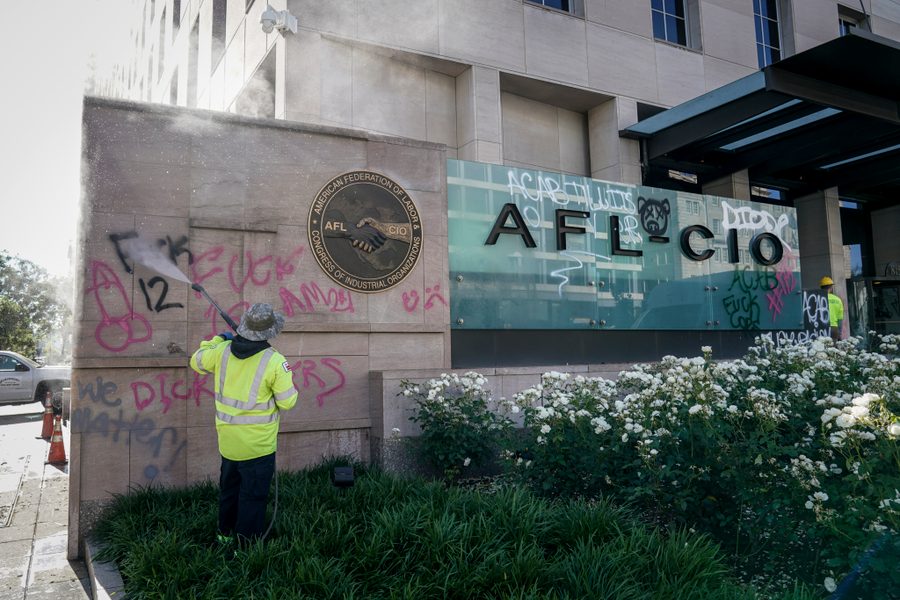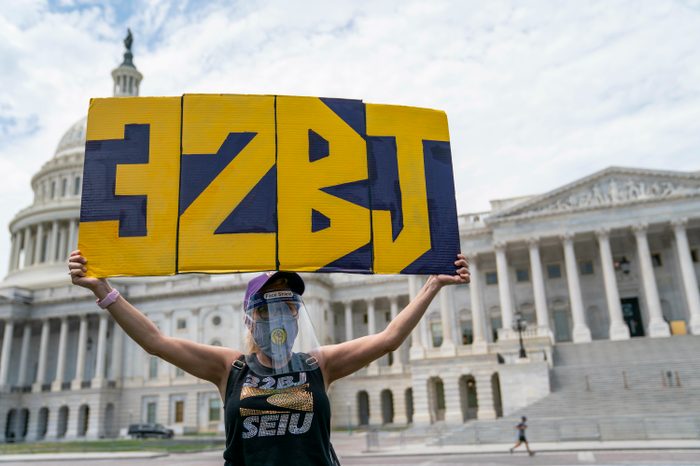The Year That Labor Hung On By Its Fingertips
Disasters, missed opportunities, and a few bright spots in 2020.
Hamilton Nolan

A lot of things happened for working people this year, and most of them were bad. But even in a year as deranged as 2020, the broader themes that afflict and energize the labor movement have carried on. If you are reading this, congratulations: There is still time for you to do something about all of these things. Here is a brief look at the Year in Labor, and may we never have to live through something like it again.
The pandemic
Broadly speaking, there have been two very large labor stories this year. The first is, “I have been forced into unemployment due to the pandemic, and I am scared.” And the second is, “I have been forced to continue working during the pandemic, and I am scared.” America’s labor reporters spent most of our year writing variations of these stories, in each company and in each industry and in each city. Those stories continue to this day.
The federal government left working people utterly forsaken. They did not create a national wage replacement system to pay people to stay home, as many European nations did. OSHA was asleep on the job, uninterested in workplace safety related to coronavirus. Republicans in Congress were more intent on getting liability protections for employers than on doing anything, anything at all, that might help desperate regular people. And, of course, Trump and his allies unnecessarily politicized public health, leading directly to hundreds of thousands of unnecessary deaths and the economic destruction that goes with that. It was a bad year. The larger political institutions created to protect workers did not do their jobs. The labor movement was left very much on its own. And its own track record was mixed.
Front-line workers
The year of the hero! We love our heroes! Our front-line workers, our delivery people and sanitation workers and bus drivers, our paramedics and nurses, our cooks and cleaners and grocery workers: We love you all! Sure, we will bang pots and pans to celebrate regular workers who had to push through during the pandemic, and we will write you nice notes and have school children draw signs celebrating you. But will you get paid for this?
How well have unions representing these front line workers done this year? In many cases, not well. I think first of the grocery workers, represented by UFCW, who were generally awarded with temporary “hazard pay” bonuses rather than actual raises. Or of the UFCW’s meatpacking workers, whose plants were encouraged to stay open by an executive order, and who suffered terribly from the coronavirus and from management’s utter disdain for their welfare. These are workers who, particularly during the early phase of the pandemic, had a ton of leverage. Had they struck, or walked out, asking for basic safety and fair pay for risking their lives, the public would have neared panic, and their demands probably would have been met. Their employers would have had no choice. Instead, there was a great deal of outcry from their unions, but no real labor actions at scale. Thus, the meatpacking workers continued to suffer, and the grocery workers saw their “hazard pay” bonuses disappear, and here we are.
The point of this is not to be harsh. Faced with an unexpected disaster, most unions have spent this year scrambling desperately to keep themselves and their workers afloat, and have been flooded with the task of dealing with the catastrophe that has cost millions their jobs. But when this is all over, there should be a serious postmortem about what could and should have been done better. And that will include, right up top, the failure of front line workers to turn their newfound hero status — and the temporary, absolute necessity that they continue working through life-threatening conditions — into any lasting gains. It is easy to surrender to the feeling of just being thankful to be employed while others sink into poverty. But we need to be ready with a better plan for next time. Billions of dollars and a good deal of potential power that working people could have had has evaporated because unions were not prepared to act to take it.
Public workers
Teachers unions conclusively demonstrated their value this year. In general, in cities with strong teachers unions, public schools did not reopen unless the teachers were satisfied that adequate workplace safety procedures were in place. (In practice this meant that many school districts simply kept instruction online.) While this earned the ire of some parents, they should think it through: Workplace safety in America only existed where unions were strong enough to see to it that it happened. Schools were the most prominent example of that.
Elsewhere, the news for federal government employees was gloomy. The Trump administration waged a years-long war against the labor rights of federal workers, and it is fair to say that the unions lost that war. Federal employee unions in particular, and state employee unions in Republican states, have become pathetically weak. Much of their bargaining power has been outlawed by Republican politicians. The unions have been reduced to writing politely angry letters as their workers are abused while waiting for a new Democratic administration that they can beg to restore their rights. It is not a workable model for a union. These unions must decide at some point that they are willing to break the law in order to assert the fundamental rights of their members, or they will grow increasingly less able to demonstrate to members why they have any value.
That may not be fair, but it’s the truth.
Organizing
The biggest issue for unions in America — bigger than any pandemic or presidential election cycle — is that there are simply not enough union members. Only one in 10 workers is a union member. In the private sector, that figure is just over 6%. The decades-long decline of union density is the underlying thing robbing the once-mighty labor movement (and by extension, the working class itself) of power. If unions in America are not growing every year, they are dying.
Disastrous years like 2020 tend to put structural issues on the back burner, but they can also serve as inspirations for people to join unions to protect them. The annual figures for the year are not out yet, but anecdotally, union leaders and organizers are optimistic that the pandemic’s havoc will serve as fuel for future organizing. Most unions managed to at least continue major organizing efforts that were already underway this year, like SEIU’s successful conclusion of a 17-year battle to unionize 45,000 child care providers in California. Industries that were already hotbeds of organizing tended to remain so. The safety net of a union contract clearly demonstrated its value far and wide this year, at least in the ability of union members to negotiate terms for furloughs and severance and recall rights and all the other things that matter during disasters, as non-union workers were simply cast out on their own.
Still, it is up to unions themselves to have a concerted plan to take advantage of the widespread national suffering and channel it into new organizing. Since unions have spent the year transfixed by the election and by trying to respond to the economic collapse, it is safe to say that such a concerted plan does not really exist yet. That needs to be done, soon, or this moment will have been wasted.

Strikes
During the early months of the pandemic, a fragile sort of labor peace reigned. The grip of the crisis was such that most workers were simply trying to hang on. As time went by, and the failures of employers became more clear, that peace began to evaporate. Teachers unions around the country used credible strike threats to head off unsafe school opening plans. And in the healthcare industry, unions have had multiple strikes, as nurses and hospital workers have passed their breaking points.
Leverage for workers varies widely by industry right now, as certain industries are besieged with unemployed workers looking for any job they can get (restaurants), and others are desperate for skilled workers, who are extremely vital (nurses). At minimum, every union should look at its leverage in the specific context of the pandemic and ask if they should act now, lest an opportunity be lost forever.
Gig workers
You can think of many enormous companies as huge algorithms that are making their way through the American labor force, turning employees into independent contractors or freelancers or part-timers. There is money to be made in freeing businesses from the responsibility and cost of providing for employees (a status that comes with benefits and a host of workplace rights, including the right to unionize). The “gig economy” is not just Uber and Lyft and Instacart and other companies that exclusively work in that space — it is an economic force of nature pushing every company, including yours, to get your job off its books, and to turn you into something less than a full employee.
Countering this force is probably the single most important legal and legislative issue for labor as a whole, because this process inherently acts to dissolve labor power. Unfortunately, the most important thing that happened on the issue this year was the passage of Prop 22 in California, legislation specifically designed to empower the gig economy companies to the detriment of workers. Scarier yet is the fact that the successful legislation in California will now be used as a blueprint for state legislation around the country. Companies are prepared to spend hundreds of millions or billions of dollars on this issue, because they save far more money on the back end and preserve their business model, which depends in large part in extracting wealth that once went to workers and redirecting it towards investors. Either America will have a national reckoning with what the gig economy is doing to us, or we will continue barreling towards a dystopian future of the Uber-ization of every last industry. Including yours. If ever there were a good time to launch a worker coop, it is now.
The election and Washington
After an early period of hope for a Bernie-led insurgency of the left, unions coalesced around Biden. They spent a ton of money on him, and indeed, his rhetoric and his platform are both more definitively pro-union than any president in decades. Unions expect a lot of things from Biden, and experience tells us that they will not get many of them.
What they will probably get: a much better NLRB, a functioning OSHA, a pro-labor Labor Department rather than the opposite, and, particularly for unions with longstanding ties to Biden, relatively good access to the White House. What they probably won’t get: passage of the PRO Act, a very good bill that would fix many of the worst problems with U.S. labor law, but which has no hope in a divided Congress. (And, I suspect, even with full Democratic control of Congress, many of the more centrist Democrats would suddenly find a reason to oppose the act if the Chamber of Commerce ever thought it might actually pass). It is true that the center of the Democratic Party is slowly moving left, but Biden is a man who naturally stays in the middle of everyone, and he will be conservative in his willingness to burn political capital by pushing pro-labor policies that don’t enjoy some amount of public bipartisan support. The political climate for unions will be similar to what it was under Obama. The words will be nicer, but any action will have to be propelled by people in the streets.
The nine-month odyssey between the passage of the CARES Act and the next relief bill that Congress actually passed is a useful demonstration of the limits of labor’s lobbying power. While particular unions, especially those in transportation and the USPS, showed skill at getting concrete material gains for their members into bills, the inability to force any sort of timely action from Congress in the face of massive human suffering shows that labor as a special interest will never have the political power it craves. Until many, many more Americans are union members, it will be impossible to break out of this trap.
The labor movement at its highest level must break itself of the addiction to the false belief that salvation will be found if only our Democrat can win the next election. It won’t. Organize millions of new workers and teach them to always be ready to strike. The Democratic Party must be dragged towards progress by an army, and our army is weak. The AFL-CIO got burned in the protests this year. It remains to be seen if it learned anything from that.
Ending on a positive note
It may be the perpetual nature of unions that the leadership is often disappointing, but the grassroots are always inspiring. The big picture for organized labor in 2020 has been… close to okay, in some aspects, but certainly not great. But when you pull out a magnifying glass and look at what individual workers and workplaces and units are doing, you will find thousands and thousands of inspiring things. And not even a pandemic has changed the basic fact that organizing is the most powerful tool that regular people have at their disposal in a system that values capital over humanity.
If you are an employee, you can unionize your workplace. If you are a gig or temporary worker, you can organize with your coworkers. If you are unemployed, you can march in the streets now, and unionize your next job. All the labor movement is is all of us.
Hamilton Nolan is a labor writer for In These Times. He has spent the past decade writing about labor and politics for Gawker, Splinter, The Guardian, and elsewhere. More of his work is on Substack.








